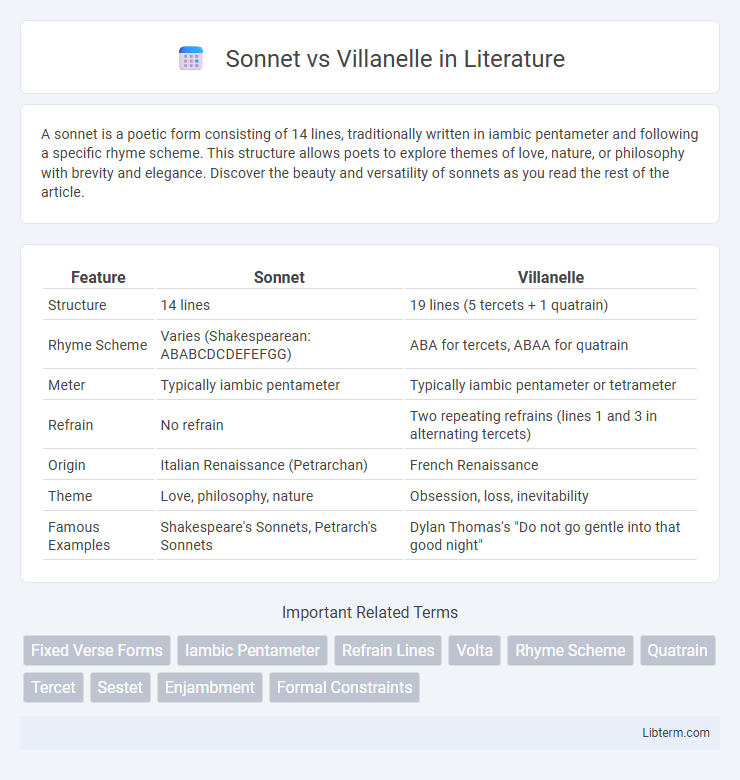A sonnet is a poetic form consisting of 14 lines, traditionally written in iambic pentameter and following a specific rhyme scheme. This structure allows poets to explore themes of love, nature, or philosophy with brevity and elegance. Discover the beauty and versatility of sonnets as you read the rest of the article.
Table of Comparison
| Feature | Sonnet | Villanelle |
|---|---|---|
| Structure | 14 lines | 19 lines (5 tercets + 1 quatrain) |
| Rhyme Scheme | Varies (Shakespearean: ABABCDCDEFEFGG) | ABA for tercets, ABAA for quatrain |
| Meter | Typically iambic pentameter | Typically iambic pentameter or tetrameter |
| Refrain | No refrain | Two repeating refrains (lines 1 and 3 in alternating tercets) |
| Origin | Italian Renaissance (Petrarchan) | French Renaissance |
| Theme | Love, philosophy, nature | Obsession, loss, inevitability |
| Famous Examples | Shakespeare's Sonnets, Petrarch's Sonnets | Dylan Thomas's "Do not go gentle into that good night" |
Definition of Sonnet
A sonnet is a 14-line poem traditionally written in iambic pentameter, often structured into three quatrains followed by a concluding couplet, with a specific rhyme scheme such as Shakespearean (ABABCDCDEFEFGG) or Petrarchan (ABBAABBACDCDCD). Sonnets typically explore themes of love, time, and nature, using a volta or "turn" to introduce a shift in argument or perspective. Villanelles, in contrast, consist of 19 lines with a fixed form and repeating refrains, emphasizing lyrical repetition rather than the logical progression found in sonnets.
Definition of Villanelle
The villanelle is a 19-line poetic form structured with five tercets followed by a quatrain, characterized by two repeating refrains and a strict rhyme scheme (ABA ABA ABA ABA ABA ABAA). Unlike the sonnet, which consists of 14 lines and varies between Shakespearean or Petrarchan forms, the villanelle employs repetition and circularity to emphasize thematic intensity. Dylan Thomas's "Do Not Go Gentle into That Good Night" exemplifies the villanelle's use of refrains to create emotional resonance.
Historical Origins
The sonnet originated in 13th-century Italy, pioneered by Giacomo da Lentini and popularized by Petrarch, emphasizing structured quatrains and a concluding couplet. The villanelle, with roots in 16th-century French pastoral poetry, became known for its fixed 19-line format, featuring repeating refrains and tercets. Both forms evolved to reflect distinct cultural and linguistic traditions in European poetic history.
Structure and Form Comparison
A sonnet traditionally consists of 14 lines written in iambic pentameter, often divided into an octave and a sestet or three quatrains followed by a couplet, following rhyme schemes like Shakespearean (ABABCDCDEFEFGG) or Petrarchan (ABBAABBACDCDCD). In contrast, a villanelle has 19 lines made up of five tercets followed by a quatrain, featuring two repeating refrains and a strict ABA rhyme scheme. The sonnet's structured variation offers thematic flexibility, while the villanelle's repetitive form emphasizes cyclical and lyrical qualities.
Rhyme Schemes Explained
The sonnet traditionally follows a 14-line structure with specific rhyme schemes such as the Shakespearean ABABCDCDEFEFGG or the Petrarchan ABBAABBACDCDCD patterns. Villanelles consist of 19 lines with a fixed rhyme scheme of ABA for five tercets followed by an ABAA quatrain, featuring two repeating refrains. The repeating rhyme and refrain structure of villanelles create a musical, cyclical effect, contrasting with the sonnet's more varied and flexible rhyme arrangement.
Themes Commonly Explored
Sonnets often explore themes of love, beauty, mortality, and the passage of time, using structured rhyme schemes to convey deep emotional and philosophical reflections. Villanelles emphasize themes of obsession, loss, and cyclical despair, utilizing repetitive refrains to create a haunting, echoing effect that reinforces the poem's emotional intensity. Both forms delve into human experience but differ in approach, with sonnets offering concise meditation and villanelles presenting persistent, recursive emotion.
Notable Examples of Each Form
Shakespeare's Sonnet 18 ("Shall I compare thee to a summer's day?") exemplifies the timeless structure and emotional depth of the sonnet form, often featuring 14 lines with a rhyme scheme of ABABCDCDEFEFGG. In contrast, Dylan Thomas's "Do not go gentle into that good night" showcases the villanelle's repetitive and lyrical nature, characterized by 19 lines, five tercets, and a quatrain with two refrains and two repeating rhymes. Both forms highlight unique poetic techniques that have influenced English literature and remain popular among poets for expressing intense emotions and memorable themes.
Famous Poets Who Used Sonnets and Villanelles
William Shakespeare and Elizabeth Barrett Browning are renowned for their masterful use of sonnets, shaping the form through expressive themes of love and human experience. In contrast, poets like Dylan Thomas and Sylvia Plath gained acclaim for their use of villanelles, employing its repetitive structure to evoke intense emotion and psychological depth. These iconic poets exemplify how sonnets and villanelles serve as distinct vehicles for powerful poetic expression across literary history.
Writing Challenges and Techniques
Sonnets demand mastery of a strict structure with 14 lines and a specific rhyme scheme, often iambic pentameter, which challenges writers to express complex ideas concisely. Villanelles require skillful repetition, with two refrains alternating throughout 19 lines, creating rhythmic intensity and thematic emphasis. Both forms push poets to balance creativity and constraint while employing advanced techniques like rhyme, meter, and refrain for emotional resonance.
Choosing Between a Sonnet and a Villanelle
Choosing between a sonnet and a villanelle depends on the desired structure and emotional impact of the poem. Sonnets typically consist of 14 lines with a specific rhyme scheme, ideal for exploring themes of love and introspection with a controlled volta or thematic turn. Villanelles, with their 19-line structure and repetitive refrains, excel at emphasizing cyclical emotions and creating a haunting, rhythmic resonance.
Sonnet Infographic

 libterm.com
libterm.com